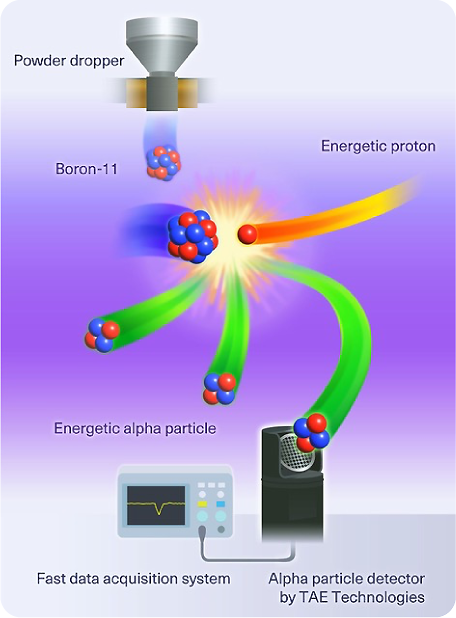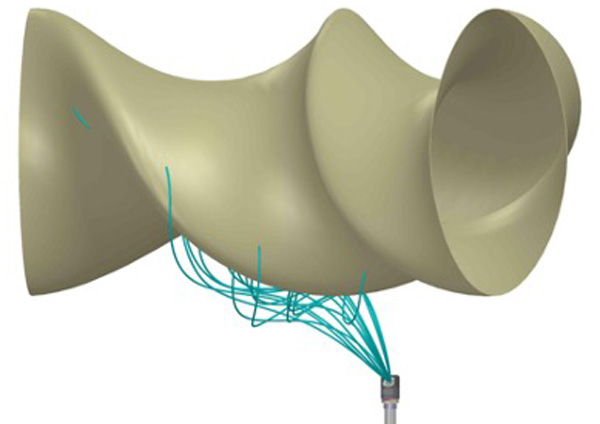TAE Technologies and Japan’s National Institute for Fusion Science (NIFS) begin joint experiments with new fusion fuel
As the scientific community—and arguably, the world—experiences renewed interest in the development of fusion energy, it’s worth highlighting the diversity of approaches being pursued. Fusion pioneers are developing a variety of machines that employ a variety of fuels each with their own set of attractive features and technical challenges, but all with the same goal – to develop the technology that enables commercial electricity production from fusion energy. The innovations we’re seeing now, largely in the private sector, represent a wealth of scientific and engineering prowess built on decades of research and experimentation.
When it comes to fuel, hydrogen-boron (p-B11) has long been recognized as attractive for a fusion reactor, for good reason. Both components are cheap and abundant; they can be readily extracted from seawater, or, in the case of boron, easily mined from the surface of the earth. Both are non-toxic and non-radioactive. And the products of the reaction – three helium atoms called alpha particles – are themselves benign.
Despite these clear advantages, most fusion research efforts to date have focused instead on using a mix of two hydrogen isotopes, deuterium and tritium, because it requires a much lower operating temperature – more than an order of magnitude lower – than p-B11. Developing the technology to create and confine the higher temperature p-B11 plasma has therefore been deemed more challenging.
While the p-B11 reaction has been studied theoretically, in laser driven fusion devices, and with particle accelerators, it has never before been studied in a magnetically confined, thermonuclear plasma. The new paper we co-authored for Nature Communications, with colleagues at TAE Technologies and Japan’s National Institute for Fusion Science, describes how this was accomplished through the simple combination of hydrogen, boron, and a lot of energy.
TAE has been pursuing p-B11 fusion since its inception. In fact, the company’s original name, Tri Alpha Energy, references the reaction’s products. Its current experimental device, known as Norman, named after the company’s late technology co-founder, Dr. Norman Rostoker, is (for now) fueled with hydrogen only, on the path to developing a magnetic confinement fusion reactor capable of burning p-B11 in a scaled-up version of the device.
A challenge in any magnetic fusion device is maintaining pristine vacuum conditions inside the confinement vessel so that when the fuel gas is puffed in and ionized, the resulting plasma is free of impurities which can radiate away energy. To help keep the vessel clean, the LHD uses a “boronization” system, which coats the walls of the chamber with a thin layer of boron to help remove impurities from the plasma. The system, known as the Impurity Powder Dropper (IPD), developed at Princeton Plasma Physics Laboratory, drops boron powder into the hydrogen plasma which ionizes the boron and distributes it throughout the chamber.

Serendipitously then, the necessary ingredients for p-B11 fusion – high energy protons and a boron target plasma – are created in the LHD (see Figure 1 for a rendering of the experimental set-up). Previous work by Ogawa et al1 calculated the expected rate of p-B11 fusion in the LHD plasma using the measured boron density and profile of fast ions as inputs. All that was needed was a detector to measure the products of the reaction.
Thermonuclear plasmas emit many forms of radiation, from x-rays to energetic neutral particles to fusion products, so the challenge of the measurement is distinguishing the alphas from the cacophonous background. To minimize this background, the detector was oriented to not have a direct line-of-sight to the plasma and relied on the 3 Tesla magnetic field of the LHD to steer the charged alpha particles into the detector. Additionally, a thin shield (a platinum foil 2 microns thick – about 1/100 the width of a human hair) was placed in front of the detector to shield out low energy x-rays while allowing the high energy alphas to pass.

The scientific team at TAE developed the Alpha Particle Detector for an experiment on the Large Helical Device (LHD) experiment. The LHD is a large magnetic confinement fusion experiment located in Toki, Japan that has been in operation since 1998. It uses superconducting magnets to create a helical magnetic field to confine a hydrogen plasma. It also employs a suite of Neutral Beams which inject beams of very energetic neutral hydrogen atoms into the plasma to create a circulating population of what are known as fast ions (protons, in this case) to heat the plasma.
In order to confirm that the signal isolated from the detector was indeed from alphas, we performed a couple of checks. First, the null tests: we fired the beams into a boron-free plasma and injected boron into a plasma without circulating fast protons. In both cases, the signal vanished. Second, we compared the dynamics of the measured signal on the detector to the dynamics of the global rate calculated by the simulation used in Ogawa et al. As shown in the paper, there is very good agreement to the shape of the curves. These checks confirm that the measured signal is from p-B11 fusion.
The challenge of developing scenarios for the high energy plasma operation required for p-B11 fusion requires experimental tests of the reaction in the environment in which it will be employed – a magnetically confined, thermonuclear plasma. This paper represents a milestone in that development as it marks the first such experimental measurements.
Future work includes measuring the fusion reaction rate for different neutral beam injection scenarios and the resulting energy spectrum of alphas produced. As the paper echoes, the physics challenges of pB11 fusion can only be overcome with experimentation, and those experiments have begun.
References
1Ogawa, K. et al. Evaluation of alpha particle emission rate due to the p-11B fusion reaction in the large helical device. Fusion Sci. Technol.78, 175 (2022).